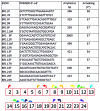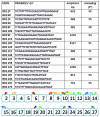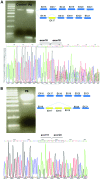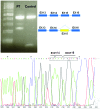Characterization of three alternative transcripts of the BRCA1 gene in patients with breast cancer and a family history of breast and/or ovarian cancer who tested negative for pathogenic mutations
- PMID: 25683334
- PMCID: PMC4356434
- DOI: 10.3892/ijmm.2015.2103
Characterization of three alternative transcripts of the BRCA1 gene in patients with breast cancer and a family history of breast and/or ovarian cancer who tested negative for pathogenic mutations
Abstract
The study of BRCA1 and BRCA2 genes and their alterations has been essential to the understanding of the development of familial breast and ovarian cancers. Many of the variants identified have an unknown pathogenic significance. These include variants which determine alternative mRNA splicing, identified in the intronic regions and those are capable of destroying the splicing ability. The aim of this study was to detect BRCA1/BRCA2 aberrant transcripts resulting from alternative splicing, in women with a known family history and/or early onset of breast and/or ovarian cancer, tested wild-type for BRCA1 and BRCA2. The identification and characterization of aberrant transcripts through the analysis of mRNA levels in blood lymphocytes may help us to recognize families otherwise misclassified as wild-type BRCA1 and BRCA2. Blood samples were collected from 13 women that had a family history of breast and/or ovarian cancer and tested negative for pathogenic mutations in the BRCA1 and BRCA2 genes. Total RNA was analyzed for the presence of BRCA1 and BRCA2 naturally occurring and pathological transcripts using RT-PCR. In 2 out of the 13 samples, 2 alternative transcripts of the BRCA1 gene were identified. These were probably pathogenic as they lacked exon 17 and exon 15, respectively, giving rise to a truncated protein. In addition to these, we identified the Δ17-19 transcript in 1 patient, which gives rise to a protein with an in-frame deletion of 69 amino acids. In conclusion, this study on alternative transcripts of the BRCA1 and BRCA2 genes revealed the presence of isoforms (prevalence of 15%) in blood samples from women with breast and ovarian cancer that were probably pathogenic, that were not detected by conventional methods of mutation screening based on direct sequencing of all coding regions, intron-exons junctions and MLPA analysis.
Figures




Similar articles
-
Novel germline mutations in breast cancer susceptibility genes BRCA1, BRCA2 and p53 gene in breast cancer patients from India.Breast Cancer Res Treat. 2004 Nov;88(2):177-86. doi: 10.1007/s10549-004-0593-8. Breast Cancer Res Treat. 2004. PMID: 15564800
-
High proportion of recurrent germline mutations in the BRCA1 gene in breast and ovarian cancer patients from the Prague area.Breast Cancer Res. 2005;7(5):R728-36. doi: 10.1186/bcr1282. Epub 2005 Jul 19. Breast Cancer Res. 2005. PMID: 16168118 Free PMC article.
-
Differentiating pathogenic mutations from polymorphic alterations in the splice sites of BRCA1 and BRCA2.Genes Chromosomes Cancer. 2003 Jul;37(3):314-20. doi: 10.1002/gcc.10221. Genes Chromosomes Cancer. 2003. PMID: 12759930
-
Gene analysis techniques and susceptibility gene discovery in non-BRCA1/BRCA2 familial breast cancer.Surg Oncol. 2015 Jun;24(2):100-9. doi: 10.1016/j.suronc.2015.04.003. Epub 2015 Apr 13. Surg Oncol. 2015. PMID: 25936246 Review.
-
Health Care Disparities in Hereditary Ovarian Cancer: Are We Reaching the Underserved Population?Curr Treat Options Oncol. 2016 Aug;17(8):39. doi: 10.1007/s11864-016-0417-1. Curr Treat Options Oncol. 2016. PMID: 27315065 Review.
Cited by
-
Emerging technologies for salivaomics in cancer detection.J Cell Mol Med. 2017 Apr;21(4):640-647. doi: 10.1111/jcmm.13007. Epub 2016 Nov 13. J Cell Mol Med. 2017. PMID: 27862926 Free PMC article. Review.
-
No Evidence for the Pathogenicity of the BRCA2 c.6937 + 594T>G Deep Intronic Variant: A Case-Control Analysis.Genet Test Mol Biomarkers. 2018 Feb;22(2):85-89. doi: 10.1089/gtmb.2017.0187. Epub 2018 Jan 22. Genet Test Mol Biomarkers. 2018. PMID: 29356578 Free PMC article.
-
Translating RNA sequencing into clinical diagnostics: opportunities and challenges.Nat Rev Genet. 2016 May;17(5):257-71. doi: 10.1038/nrg.2016.10. Epub 2016 Mar 21. Nat Rev Genet. 2016. PMID: 26996076 Free PMC article. Review.
-
Decoding the Transcriptional Complexity of the Human BRCA2 DNA Repair Gene Using Hybrid-seq.Biochem Genet. 2025 Jul 10. doi: 10.1007/s10528-025-11180-6. Online ahead of print. Biochem Genet. 2025. PMID: 40640493
-
Technological advances in the diagnosis and management of inherited optic neuropathies.Front Neurol. 2025 Jul 25;16:1609033. doi: 10.3389/fneur.2025.1609033. eCollection 2025. Front Neurol. 2025. PMID: 40786632 Free PMC article. Review.
References
-
- Sanz DJ, Acedo A, Infante M, Durán M, Pérez-Cabornero L, Esteban-Cardeñosa E, Lastra E, Pagani F, Miner C, Velasco EA. A high proportion of DNA variants of BRCA1 and BRCA2 is associated with aberrant splicing in breast/ovarian cancer patients. Clin Cancer Res. 2010;16:1957–1967. doi: 10.1158/1078-0432.CCR-09-2564. - DOI - PubMed
Publication types
MeSH terms
Substances
LinkOut - more resources
Full Text Sources
Other Literature Sources
Medical
Miscellaneous

